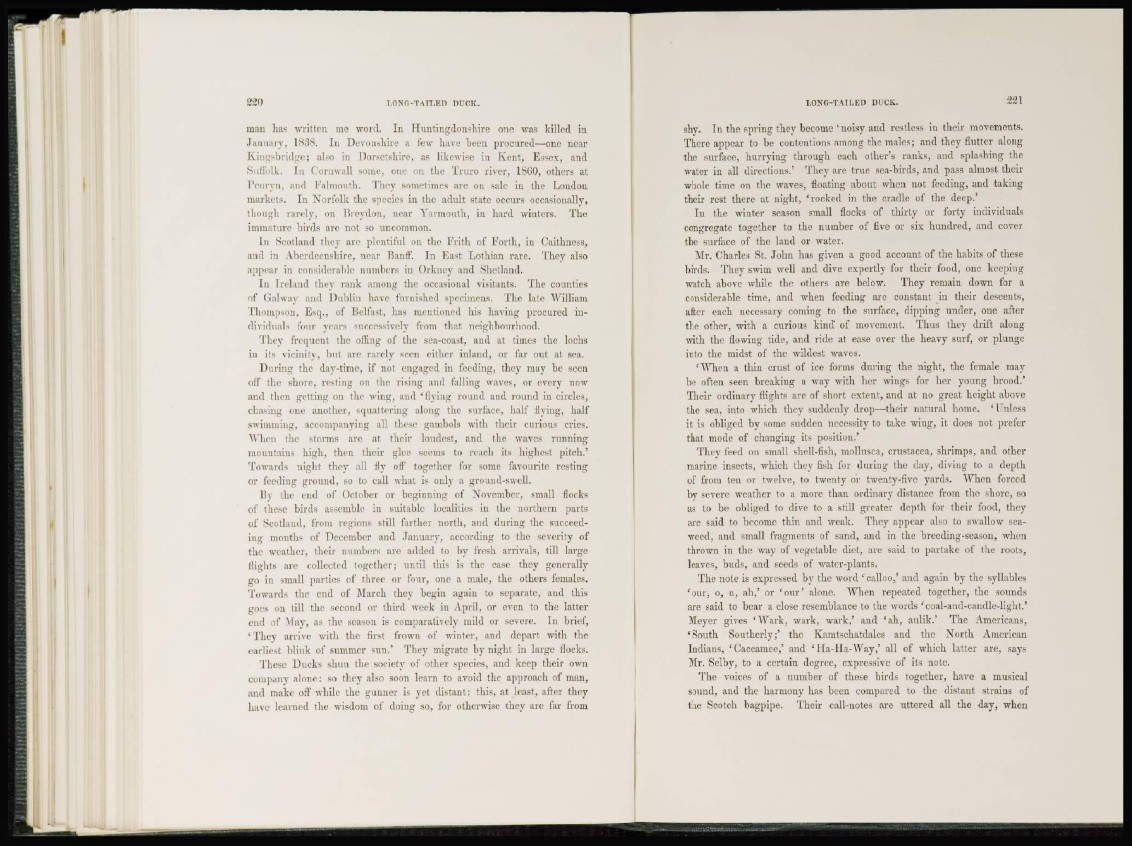
man has written me word. In Huntingdonshire one was killed in
January, 1888. In Devonshire a few have been procured—one near
Kingsbridge; also in Dorsetshire, as likewise in Kent, Essex, and
Suffolk. In Cornwall some, one on the Truro river, 1860, others at
Penryn, and Falmouth. They sometimes are on sale in the London
markets. In Norfolk the species in the adult state occurs occasionally,
though rarely, on Brcvdou, near Yarmouth, in hard winters. The
immature birds are not so uncommon.
In Scotland they are plentiful on the Frith of Forth, in Caithness,
and in Aberdeenshire, near Banff. In East Lothian rare. They also
appear in considerable numbers in Orkney and Shetland.
I n Ireland they rank among the occasional visitants. The counties
of Galway and Dublin have furnished specimens. The late William
Thompson, Esq., of Belfast, has mentioned his having procured individuals
four years successively from that neighbourhood.
They frequent the offing of the sea-coast, and at times the lochs
in its vicinity, but are rarely seen either inland, or far out at sea.
During the day-time, if not engaged in feeding, they may be seen
off the shore, resting on the rising and falling waves, or every now
and then getting on the wing, and 'flying round and round in circles,
chasing one another, sqnattering along the surface, half flying, half
swimming, accompanying all these gambols with their curious cries.
When the storms are at their loudest, and the waves running
mountains high, then their glee seems to reach its highest pitch.'
Towards night they all fly off together for some favourite resting
or feeding ground, so to call what is only a ground-swell.
By the end of October or beginning of November, small flocks
of these birds assemble in suitable localities in the northern parts
of Scotland, from regions still farther north, and during the succeeding
months of December and January, according to the severity of
the weather, their numbers are added to by fresh arrivals, till large
flights are collected together; until this is the case they generally
go in small parties of three or four, one a male, the others females.
Towards the end of March they begin again to separate, and this
goes on till the second or third week in April, or even to the latter
end of May, as the season is comparatively mild or severe. In brief,
' T h e y arrive with the first frown of winter, and depart with the
earliest blink of summer sun.' They migrate by night in large flocks.
These Ducks shun the society of other species, and keep their own
company alone: so they also soon learn to avoid the approach of man,
and make off while the gunner is yet distant: this, at least, after they
have learned the wisdom of doing so, for otherwise they are far from
shy. In the spring they become ' noisy and restless in their movements.
There appear to be contentions among the males; and they flutter along
the surface, hurrying through each other's ranks, and splashing the
water in all directions.' They are true sea-birds, and pass almost their
whole time on the waves, floating about when not feeding, and taking
their rest there at night, 'rocked in the cradle of the deep.'
I n the winter season small flocks of thirty or forty individuals
congregate together to the number of five or six hundred, and cover
the surface of the land or water.
Mr. Charles St. John has given a good account of the habits of these
birds. They swim well and dive expertly for their food, one keeping
watch above while the others are below. They remain down for a
considerable time, and when feeding are constant in their descents,
after each necessary coming to the surface, dipping under, one after
the other, with a curious kind of movement. Thus they drift along
with the flowing tide, and ride at ease over the heavy surf, or plunge
into the midst of the wildest waves.
' W h e n a thin crust of ice forms during the night, the female may
he often seen breaking a way with her wings for her young brood.'
Their ordinary flights are of short extent, and at no great height above
the sea, into which they suddenly drop—their natural home. 'I'nless
it is obliged by some sudden necessity to take wing, it does not prefer
that mode of changing its position.*
They feed on small shell-fish, mollusca, Crustacea, shrimps, and other
marine insects, which they fish for during the day, diving to a depth
of from ten or twelve, to twenty or twenty-five yards. When forced
by severe weather to a more than ordinary distance from the shore, so
as to be obliged to dive to a still greater depth for their food, they
are said to become thin and weak. They appear also to swallow seaweed,
and small fragments of sand, and in the breeding-season, when
thrown in the way of vegetable diet, are said to partake of the roots,
leaves, buds, and seeds of water-plants.
The note is expressed by the word ' calloo,' and again by the syllables
' o u r , o, u, ah,' or ' o u r ' alone. When repeated together, the sounds
are said to bear a close resemblance to the words 'coal-and-candle-light.'
Meyer gives ' W a r k , wark, wark,' and ( a h , aulik.' The Americans,
' S o u t h Southerly;' the Kamtschatdales and the North American
Indians, 'Caccamee,' and 'Ha-Ha-Way,' all of which latter are, says
Mr. Selby, to a certain degree, expressive of its note.
The voices of a number of these birds together, have a musical
sound, and the harmony has been compared to the distant strains of
the Scotch bagpipe. Their call-notes are uttered all the day, when